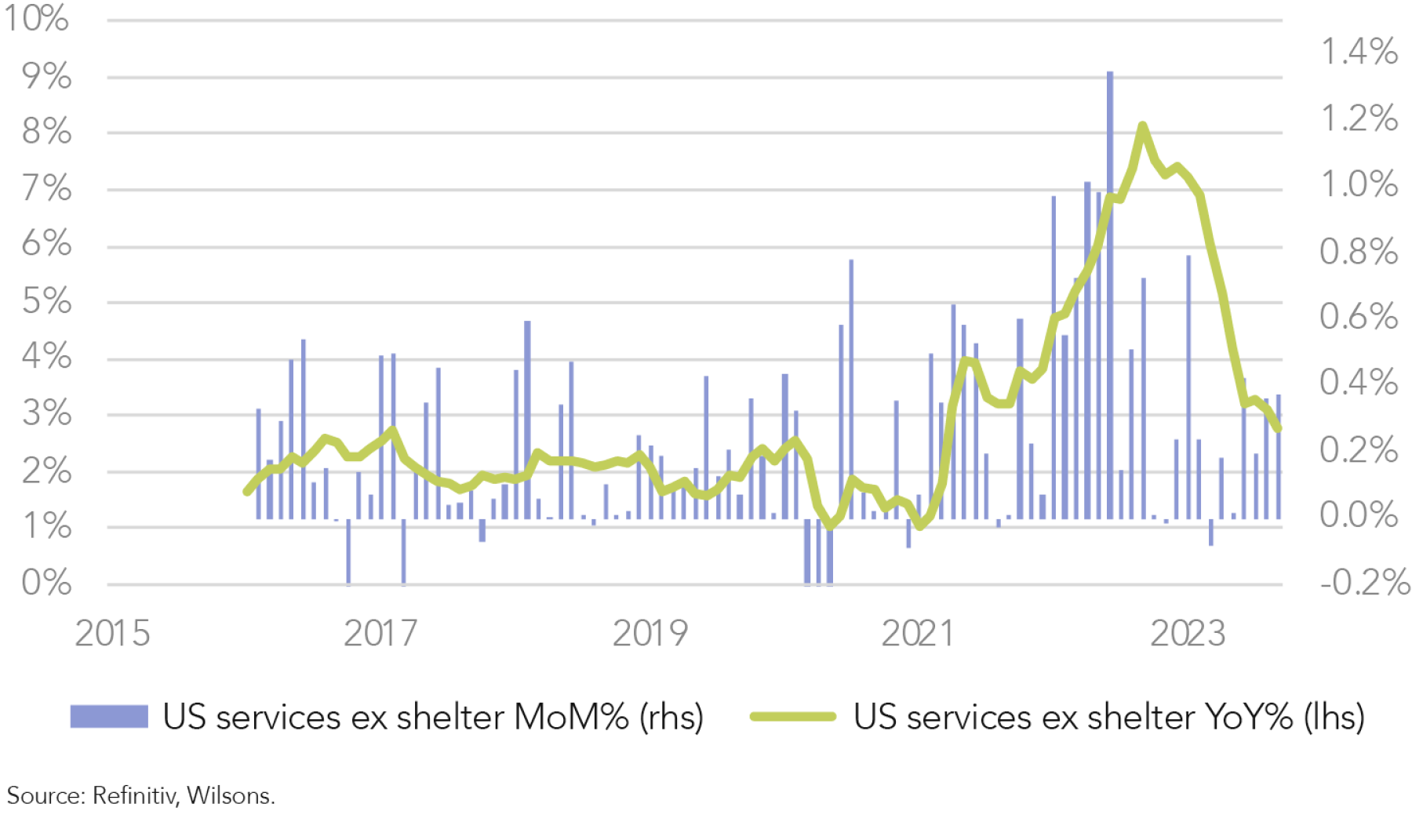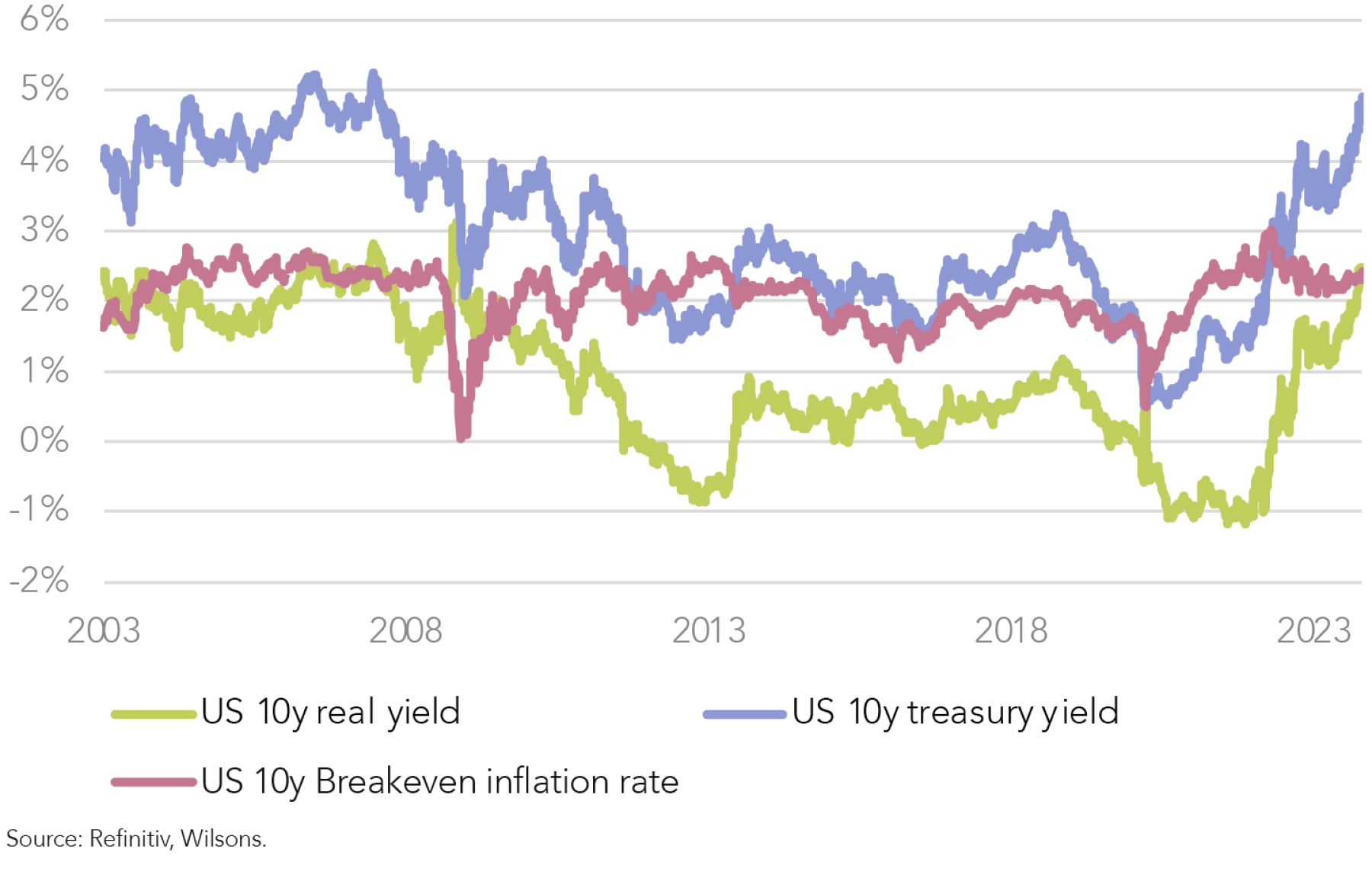
Global inflation pressures appear to be easing despite a surprisingly resilient US economy and rising concerns over the global oil price.
Our core view remains unchanged. The inflation surge witnessed in 2021 and 2022 was more transitory than structural, and in the absence of a significant energy shock we expect global inflation to ease significantly over the coming 12 months as the global economy slows. This should be supportive (all things equal) for both equities and bonds.
| Global Headline Inflation | |||
| 2022 peak | Latest Reading | 10-year Average | |
| UK* | 11.1% | 6.7% | 2.8% |
| New Zealand | 7.3% | 5.6% | 2.4% |
| Australia* | 7.8% | 5.2% | 2.5% |
| Eurozone | 10.6% | 4.3% | 2.2% |
| US | 9.1% | 3.7% | 2.7% |
| Japan* | 4.3% | 3.2% | 1.0% |
| China | 2.8% | 0.0% | 1.8% |
* UK, Australia and Japan are August readings. Rest are September. Source: Refinitiv, Wilsons.
We see logic in the idea that inflation may average moderately higher over the next 5-10 years (supply chain reconfiguration costs, energy transition costs) than it averaged in the post-GFC to pre-pandemic period. However, we believe the elevated inflation rates seen in 2021 /22 are likely to be behind us now, with global supply chains largely normalised and global excess demand easing.
While our 12-month inflation view is relatively sanguine, investors should not expect a straight-line deceleration and cannot of course ignore the geopolitical risks around global energy prices. However, our base case continues to be for significantly lower global inflation over the coming year.
Resilient US Economy Challenging the Disinflation Outlook?
US inflation trends tend to dominate investor sentiment given the dominance of the US economy and the even more notable dominance of US asset markets. We would note that inflation trends outside the US are increasingly encouraging, with Eurozone inflation beginning to fade, albeit accompanied by a marked softening in economic activity. Inflation in China is close to zero, although this in part reflects a backdrop of weak demand.
In contrast to Europe and China, US economic activity has not displayed any significant weakness of late, although the disinflation trend is relatively well established. US headline inflation peaked at 9.1% in June 2022, with the latest September 2023 reading showing 12-month inflation at 3.7% (see figure 2).
The deceleration in the closely watched “core CPI” (consumer price index) measure has been less dramatic but is still encouraging.
Core inflation peaked at 6.6% 12 months ago, with the most recent September 2023 print coming in at 4.1%. Based on the past 3 months of data, core inflation is running at an even more benign 3.0% annualised.
We agree with the Fed’s assertion that it is still too early to declare mission accomplished with respect to the inflation fight. Policy rates are likely to stay elevated for some time. Due to a combination of still highish year-on-year (YoY) inflation and very resilient economic growth, the futures market has its first cut in Q3 next year. Nevertheless, the broad disinflationary trends evident over recent quarters are encouraging, even if investor sentiment toward the path of inflation remains nervous.
Energy Headwinds Cause Headline Inflation Choppiness
Apart from the surprising resilience in the US economy, investors also remain on edge due to the recent pick-up in headline inflation driven by the recent back-up in oil prices. This rising oil price trend has been in place for a few months now, and the fragile situation in the middle east is adding to concerns.

At this stage, the rise in the global oil price is not particularly large in a long-term context, or indeed when compared specifically to the surge seen around Russia’s invasion of Ukraine. Investors remain on edge at the risk of a broadening of the Israel-Palestine conflict, which could drive a genuine surge in oil prices. We certainly recognize this risk, although significantly higher oil prices are not our central case.

Sticky Core or Statistical Blip?
Apart from the recent pickup in headline inflation, US core inflation also surprised moderately to the upside in September. This follows a pickup (albeit in line with expectations) in August. These prints followed very low reads in June and July.


Most of the recent pick up in core inflation can be attributed to the shelter/housing component of core CPI, which increased by 0.6% month-on-month (MoM) in September (See figure 6). This was far and away the largest contributor to September’s inflation lift, accounting for more than half of the monthly increase in core inflation. In contrast, core inflation excluding shelter decelerated from 0.3% MoM to 0.1% MoM.
The shelter-led monthly jump was somewhat surprising given what appeared to be a developing downtrend. A large portion of the shelter component is based on a 6-month survey of rents and imputed rents (based on a number of discrete six-monthly surveys chained together). We view this rolling survey-based approach as a somewhat lagging indicator of inflation trends in the housing sector. We note that leading indicators of shelter inflation (rents on new leases reported by real estate platform Zillow etc.) indicate that shelter inflation will continue to moderate. The September CPI inflation update does not in our view suggest that the disinflationary trend is genuinely at risk, although unfortunately shelter is both the largest and the slowest moving (most lagged) component of the CPI basket.

Core Inflation (Excluding Shelter) Steadily Improving
Putting the September core increase in the broader perspective suggests it was still another positive step along the road to slower inflation — even if that step was smaller than expected. The trend for core CPI continues to be downward. The 12-month core CPI change dipped another 0.2% to 4.1%, while the 6-month change dropped to 3.5% and the 3-month change eased to 3.0%

While progress may slow in the very short term, over the next 6 - 12 months we expect significantly lower US inflation as measured rents slow, used car prices decline, and ebbing demand lead other core goods prices to ease further.
The Fed expects core inflation to track at around 3.7% by the end of this year, before falling to 2.6% by the end of 2024. We tend to see risks for the end of 2024 as skewed moderately to the downside, relative to the Fed’s forecast, so we do think the Fed will be in a position to ease policy by the second half of next year.
One interesting aspect of inflation forecasting is assessing inflation expectations, and the question of whether expectations will remain “anchored” versus the risk that expectations of higher inflation become embedded in the economy.
From this perspective, it is important to note that the rise in bond yields experienced recently does not reflect any material lift in the market’s long-term inflation expectation. The rise in bond yields has a function of resilient growth data pushing up real yields, rather than any discernible reassessment of the long-term inflation outlook.

Further resilience in the economy (alongside higher oil prices) could perhaps threaten the disinflation trend, particularly if the labour market remains tight. We note a cooling in US wage data, despite the tight labour market. The prospect of further easing in labour market conditions should further ease wage pressure over the coming year. This should help take pressure off services inflation.

Disinflation Forces should Re-assert
In summary, it is quite possible the recent stalling in disinflation could extend for another month or 2 due to a resurgent oil price and some “technical” factors influencing core CPI. However, the ongoing disinflation trend that began to take hold over a year ago is likely to be the dominant story for the next 12 months (in the absence of a genuine oil shock).
A combination of slower growth and easing inflation should push US bond yields back down over the next 6 - 12 months, which should support the equity market although near-term volatility may well persist.
Local Inflation Pressures also Easing, though Disinflation may Take Longer
Closer to home, Australian inflation has also peaked, although our own disinflation cycle may take longer due to a weaker currency and more pronounced rent inflation. This week’s September quarter inflation data will be a key signpost and will be closely assessed by the Reserve Bank of Australia (RBA). A higher-than-expected Q3 read risks one more hike. Even in the absence of an upside surprise, any policy easing appears a fair way off. However, as with the US/global inflation cycle, we expect a broader trend of moderate disinflation will play out over the coming year.

Written by
David Cassidy, Head of Investment Strategy
David is one of Australia’s leading investment strategists.
About Wilsons Advisory: Wilsons Advisory is a financial advisory firm focused on delivering strategic and investment advice for people with ambition – whether they be a private investor, corporate, fund manager or global institution. Its client-first, whole of firm approach allows Wilsons Advisory to partner with clients for the long-term and provide the wide range of financial and advisory services they may require throughout their financial future. Wilsons Advisory is staff-owned and has offices across Australia.
Disclaimer: This communication has been prepared by Wilsons Advisory and Stockbroking Limited (ACN 010 529 665; AFSL 238375) and/or Wilsons Corporate Finance Limited (ACN 057 547 323; AFSL 238383) (collectively “Wilsons Advisory”). It is being supplied to you solely for your information and no action should be taken on the basis of or in reliance on this communication. To the extent that any information prepared by Wilsons Advisory contains a financial product advice, it is general advice only and has been prepared by Wilsons Advisory without reference to your objectives, financial situation or needs. You should consider the appropriateness of the advice in light of your own objectives, financial situation and needs before following or relying on the advice. You should also obtain a copy of, and consider, any relevant disclosure document before making any decision to acquire or dispose of a financial product. Wilsons Advisory's Financial Services Guide is available at wilsonsadvisory.com.au/disclosures.
All investments carry risk. Different investment strategies can carry different levels of risk, depending on the assets that make up that strategy. The value of investments and the level of returns will vary. Future returns may differ from past returns and past performance is not a reliable guide to future performance. On that basis, any advice should not be relied on to make any investment decisions without first consulting with your financial adviser. If you do not currently have an adviser, please contact us and we would be happy to connect you with a Wilsons Advisory representative.
To the extent that any specific documents or products are referred to, please also ensure that you obtain the relevant disclosure documents such as Product Disclosure Statement(s), Prospectus(es) and Investment Program(s) before considering any related investments.
Wilsons Advisory and their associates may have received and may continue to receive fees from any company or companies referred to in this communication (the “Companies”) in relation to corporate advisory, underwriting or other professional investment services. Please see relevant Wilsons Advisory disclosures at www.wilsonsadvisory.com.au/disclosures.
